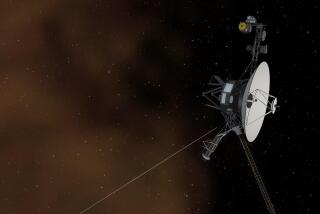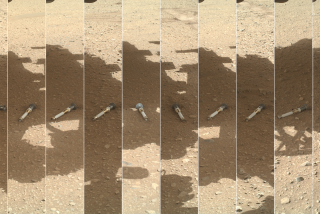Opportunity’s record-setting mission on Mars appears to have reached its end
Halfway up the slope of a crater on Mars lies a small robotic geologist that won’t wake up.
The Smart car sized rover got caught in an epic dust storm that enveloped the Red Planet in June, and it hasn’t been heard from since.
For the record:
10:30 a.m. Feb. 14, 2019A previous version of this story said the Opportunity and Spirit rovers could use their mechanical arms to grab rocks. They could not grab items, but they could inspect them up close with a microscopic imager.
For the last eight months, scientists and engineers at NASA’s Jet Propulsion Laboratory have desperately sent more than 800 commands across 35 millions miles of interplanetary space, imploring the explorer to reply with even the briefest “beep.”
In recent weeks they tried something new — asking the rover to reset its internal clock in the hopes that that would help it recharge and wake itself up.
But the robot remains silent.
“We have pretty much exhausted our recovery efforts,” said John Callas, project manager of NASA’s Mars Exploration Rover mission. “There are a couple more things we might try, but I think you can pretty much read the tea leaves on this one.”
Engineers were set to issue a final series of recovery commands Tuesday night, NASA officials said.
But if there was no response by Wednesday, the space agency was poised to announce that the rover’s record-setting mission was officially at an end.
Its name is Opportunity, and for more than 15 years it has been traversing the Martian surface, driving more than 28 miles and sending back more than 17,000 images of our nearest planetary neighbor.
Together with its twin rover, Spirit, Opportunity used the techniques of geology to show that in its distant past, Mars could have been a habitable planet — much warmer, wetter and Earthlike than it is today.
“There was certainly compelling evidence from orbital images that water once flowed across the planet, but Spirit and Opportunity were the first to tackle that question from the ground,” said Steve Squyres, a planetary scientist at Cornell University and the principal investigator for the science payload on the Mars Exploration Rover Project.
Spirit and Opportunity blasted off from Earth in July of 2003, each equipped with the tools of a human geologist. They had high-resolution panoramic cameras that gave them the equivalent of 20-20 vision, and an arm with a shoulder, elbow and wrist that allowed them to reach out toward any interesting rocks that caught their eye and inspect them up close with a microscopic imager.
The rovers reached Mars in January 2004, touching down on opposite sides of the planet.
They were designed to last 90 days in the harsh Martian environment, and to travel a total distance of 1,000 yards.
Instead, Spirit covered nearly 5 miles of Martian territory over a period of five years, until it became stuck in the powdery soil of Gusev crater.
Opportunity continued its explorations for another decade. Among its many achievements, it set an off-world driving record in 2014 when it overtook the title from the Russian rover Lunokhod 2, which drove 24.2 miles on the lunar surface. By June, Opportunity had traveled 28.06 miles on Mars.
But it’s the discoveries that scientists say they will remember.
It took only a few weeks for Opportunity to find strong evidence among the rocks on Meridiani Planum that Mars was once soaking wet. The rocks’ appearance and composition made clear to geologists that the dry and dusty planet used to have water on its surface.
Elsewhere on the Red Planet, it discovered veins of a mineral scientists believe to be gypsum. The veins are an indication that water also flowed underground, through fractures in rocks.
The rover also happened upon a variety of meteorites, spotted a towering dust devil and even watched comet Siding Spring as it streaked through the Martian sky.
NASA officials are expected to announce the results of their final attempt to rouse Opportunity around 11 a.m. Wednesday at JPL in La Cañada Flintridge.
Do you love science? I do! Follow me @DeborahNetburn and “like” Los Angeles Times Science & Health on Facebook.







